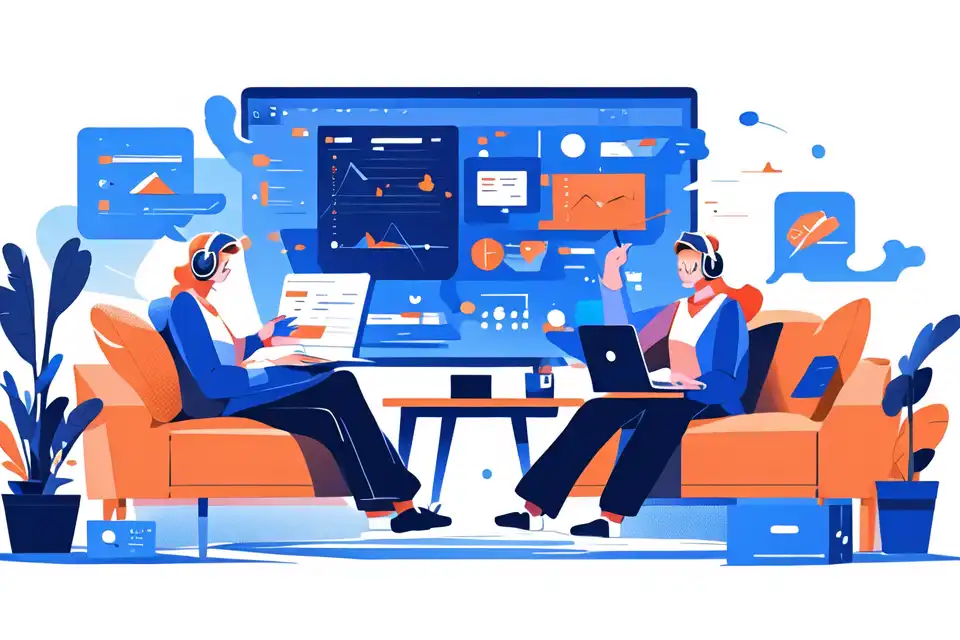Player Interaction
Unlock the potential of Player interaction with the comprehensive Lark glossary guide. Explore essential terms and concepts to excel in the gaming realm with Lark solutions.
Try Lark for Free
Player interaction is a fundamental aspect of gaming that refers to the ways in which players engage and interact with the game, as well as with other players. It encompasses various forms of communication, collaboration, competition, and cooperation that occur within the gaming environment. Player interaction plays a crucial role in shaping the gaming experience and has significant relevance in the gaming industry as a whole.
Leverage the full capabilities of Lark Base to streamline, oversee, and successfully execute your real estate strategies and initiatives.
Define player interaction and its relevance in the gaming industry
Player interaction can be defined as the exchange of actions, information, and experiences between players within a gaming environment. It involves both direct and indirect interactions, including in-game communication, multiplayer gameplay, social features, and community engagement.
The relevance of player interaction in the gaming industry cannot be overstated. For gamers, it enhances the overall gaming experience by providing opportunities for socialization, teamwork, and competition. It allows players to connect with friends, meet new people, and build communities around shared interests. Moreover, player interaction fosters a sense of immersion, realism, and emotional engagement, making the gaming experience more enjoyable and memorable.
From the perspective of gaming businesses, understanding player interaction is vital for several reasons. Firstly, it enables developers and publishers to create games that cater to the preferences and needs of the target audience. By analyzing player interactions, they can identify popular features, improve gameplay mechanics, and design engaging multiplayer experiences. This knowledge helps in developing successful titles that attract a large player base and generate revenue.
Furthermore, player interaction plays a crucial role in player retention and monetization strategies. Games with strong social and interactive elements tend to have higher player engagement and longer playtime. This, in turn, increases the likelihood of players making in-game purchases or subscribing to premium features. Understanding player interaction allows businesses to optimize their monetization models and develop effective marketing campaigns that resonate with the target audience.
In summary, player interaction is relevant in the gaming industry as it enhances the gaming experience for players and provides valuable insights for gaming businesses to create successful titles and drive revenue.
Significance of player interaction in gaming
The significance of player interaction in gaming cannot be underestimated. It influences various aspects of the gaming experience and has a profound impact on both players and gaming businesses.
One of the key benefits of player interaction is the social aspect it brings to gaming. Many players enjoy connecting with others, whether it's playing cooperatively to achieve common goals or engaging in friendly competition. Player interaction fosters a sense of community, belonging, and shared experiences. It allows players to form friendships, join clans or guilds, and participate in online events and tournaments. This social aspect not only enhances the enjoyment of the game but also provides opportunities for personal growth, teamwork, and collaboration.
Player interaction also contributes to the longevity of games. By enabling multiplayer gameplay, developers can create experiences that offer endless possibilities and challenges. Multiplayer modes, whether competitive or cooperative, provide a dynamic and ever-changing environment that keeps players engaged and coming back for more. Additionally, player interaction can lead to the creation of user-generated content, such as mods, maps, and custom game modes, which further extend the lifespan of games and foster a dedicated player community.
From a business perspective, understanding player interaction is crucial for the success of gaming companies. By analyzing player behavior and preferences, businesses can make informed decisions regarding game design, updates, and new features. This knowledge allows them to tailor their products to meet the needs and desires of the target audience, resulting in higher player satisfaction and increased player retention.
Moreover, player interaction is closely tied to monetization strategies in the gaming industry. By implementing social features and in-game economies, developers can create opportunities for players to spend money on virtual goods, cosmetic items, or premium features. Strong player interaction enhances the value proposition of these offerings and increases the likelihood of players making purchases. This, in turn, drives revenue and ensures the financial sustainability of gaming businesses.
In conclusion, player interaction is significant in gaming as it enhances the social aspect of gaming, prolongs the lifespan of games, and provides valuable insights for gaming businesses to improve their products and drive revenue.
Who benefits from player interaction in gaming
Player interaction benefits various stakeholders within the gaming ecosystem. Let's explore how each of these stakeholders benefits from player interaction:
-
Players: Players are the primary beneficiaries of player interaction in gaming. It provides them with opportunities to connect with other players, form friendships, and engage in cooperative or competitive gameplay. Player interaction enhances the social aspect of gaming, making it more enjoyable and immersive. It allows players to learn from each other, share experiences, and collaborate to overcome challenges. Additionally, player interaction can lead to the creation of vibrant gaming communities where players can find support, advice, and a sense of belonging.
-
Developers: Developers benefit from player interaction by gaining insights into player behavior, preferences, and engagement patterns. By analyzing player interactions, developers can identify popular features, detect gameplay issues, and make informed decisions regarding game updates and improvements. This knowledge helps developers create games that resonate with the target audience, leading to higher player satisfaction and increased player retention. Moreover, player interaction facilitates user testing and feedback, enabling developers to refine their games and deliver a better overall experience.
-
Publishers: Publishers benefit from player interaction through increased player engagement and monetization opportunities. Strong player interaction drives player retention and increases the likelihood of players making in-game purchases. Publishers can leverage player interactions to implement effective monetization strategies, such as offering virtual goods, in-game currencies, or premium features. Additionally, player interaction can contribute to the marketing efforts of publishers, as satisfied players are more likely to recommend games to their friends and promote them through word-of-mouth.
-
Gaming Communities: Gaming communities, such as forums, social media groups, and fan websites, thrive on player interaction. These communities provide platforms for players to share their experiences, discuss strategies, and connect with like-minded individuals. Player interaction within these communities fosters a sense of camaraderie, support, and shared interests. It allows players to stay updated with the latest news, events, and developments in the gaming industry. Gaming communities also provide valuable feedback and suggestions to developers, contributing to the improvement of games and the overall gaming experience.
In summary, players, developers, publishers, and gaming communities all benefit from player interaction in gaming. It enhances the social aspect of gaming for players, provides insights and feedback for developers, drives engagement and monetization for publishers, and fosters vibrant gaming communities.
Related:
Overcast Games Software Development Service Chooses Lark to Power Effective Team CollaborationLearn more about Lark x Gaming Industry
How player interaction works for gaming businesses
Player interaction plays a crucial role in the success of gaming businesses. It not only enhances the gaming experience for players but also provides valuable insights and opportunities for revenue generation. Let's explore how player interaction works for gaming businesses and why it matters:
Practical Implications and Why It Matters
Understanding player interaction has practical implications for gaming businesses. By analyzing player behavior and engagement patterns, businesses can make informed decisions regarding game design, updates, and monetization strategies. This knowledge allows them to create games that cater to the preferences and needs of the target audience, resulting in higher player satisfaction and increased player retention.
Moreover, player interaction provides businesses with valuable feedback and insights. By actively listening to player feedback, businesses can identify areas for improvement, address gameplay issues, and implement changes that enhance the overall gaming experience. This iterative process of incorporating player feedback fosters a sense of player empowerment and involvement, leading to stronger player loyalty and advocacy.
Furthermore, player interaction opens up opportunities for revenue generation. By implementing social features, businesses can create virtual economies, in-game marketplaces, and premium offerings that provide players with additional value and incentives to spend money. Strong player interaction enhances the perceived value of these offerings, increasing the likelihood of players making in-game purchases or subscribing to premium features. This, in turn, drives revenue and ensures the financial sustainability of gaming businesses.
In summary, player interaction has practical implications for gaming businesses. By understanding player behavior, listening to player feedback, and leveraging social features, businesses can create games that resonate with the target audience, foster player loyalty, and drive revenue.
Best Practices when Considering Player Interaction in Gaming and Why It Matters
When considering player interaction in gaming, it is essential for businesses to follow best practices to ensure its effectiveness. Here are some best practices and strategies for implementing player interaction effectively:
-
Design for Social Interaction: When developing games, businesses should prioritize social features and gameplay mechanics that encourage player interaction. This can include multiplayer modes, chat systems, in-game events, and player communities. By designing games that facilitate social interaction, businesses can enhance the overall gaming experience and provide players with opportunities for collaboration, competition, and socialization.
-
Facilitate Communication: Effective communication is crucial for player interaction. Businesses should provide players with intuitive and accessible communication tools, such as voice chat, text chat, and emotes. Clear and seamless communication enhances teamwork, coordination, and socialization among players. Additionally, businesses should implement moderation systems to ensure a safe and respectful gaming environment.
-
Foster Community Engagement: Building and nurturing a vibrant gaming community is essential for player interaction. Businesses should actively engage with players through forums, social media, and events. By organizing tournaments, contests, and community-driven initiatives, businesses can foster a sense of belonging and involvement among players. This engagement not only strengthens player loyalty but also provides valuable feedback and insights for continuous improvement.
-
Listen to Player Feedback: Businesses should actively listen to player feedback and take it into account when making decisions regarding game updates and improvements. By incorporating player suggestions and addressing gameplay issues, businesses demonstrate their commitment to player satisfaction and engagement. Regularly communicating updates and changes to the player community also fosters transparency and trust.
-
Promote Positive Player Interaction: Businesses should actively promote positive player interaction and discourage toxic behavior. Implementing systems that reward sportsmanship, teamwork, and cooperation encourages players to engage in positive interactions. On the other hand, businesses should have robust reporting and moderation systems in place to address and penalize toxic behavior, ensuring a safe and enjoyable gaming environment for all players.
Implementing these best practices ensures that player interaction is effective and meaningful in gaming. By prioritizing social features, facilitating communication, fostering community engagement, listening to player feedback, and promoting positive interactions, businesses can create games that resonate with players and drive success in the gaming industry.
Actionable tips for leveraging player interaction in the gaming industry
Leveraging player interaction effectively is crucial for success in the gaming industry. Here are some actionable tips that businesses can follow to maximize the benefits of player interaction:
Tip 1: Foster a sense of community
Building a strong gaming community is essential for player interaction. Encourage players to connect with each other through in-game chat, forums, and social media platforms. Organize community events, tournaments, and contests to foster a sense of belonging and involvement. By nurturing a vibrant community, businesses can create a valuable platform for player interaction and engagement.
Tip 2: Implement social features
Integrate social features into games to facilitate player interaction. This can include multiplayer modes, guild/clan systems, and in-game communication tools. By providing players with opportunities to team up, compete, and communicate, businesses enhance the social aspect of gaming and foster player engagement.
Tip 3: Actively listen to player feedback
Regularly seek and listen to player feedback to understand their preferences and concerns. Implement feedback mechanisms within the game, such as surveys or in-game feedback forms. Actively engage with players on forums and social media to gather insights and suggestions. By incorporating player feedback, businesses demonstrate their commitment to player satisfaction and improve the gaming experience.
Tip 4: Organize community-driven events
Organize events that encourage player interaction and collaboration. This can include in-game tournaments, community challenges, or special events with unique rewards. Community-driven events foster a sense of camaraderie and competition, encouraging players to engage with each other and the game.
Tip 5: Promote positive behavior
Promote positive player interaction and discourage toxic behavior. Implement systems that reward sportsmanship and teamwork while penalizing toxic behavior. Encourage players to be respectful and supportive of each other. This creates a welcoming and enjoyable gaming environment for players, enhancing their overall experience.
By following these actionable tips, businesses can leverage player interaction effectively, creating a vibrant gaming community and driving success in the gaming industry.
Related:
Overcast Games Software Development Service Chooses Lark to Power Effective Team CollaborationLearn more about Lark x Gaming Industry
Related terms and concepts to player interaction in the gaming industry
Understanding related terms and concepts to player interaction in the gaming industry can provide a more comprehensive understanding of the topic. Here are some related terms and concepts:
Related Term or Concept 1: Multiplayer Gameplay
Multiplayer gameplay refers to the mode of gameplay where multiple players can interact and play together simultaneously. It can involve cooperative gameplay, competitive gameplay, or a combination of both. Multiplayer gameplay enhances player interaction by providing opportunities for teamwork, competition, and socialization.
Related Term or Concept 2: In-Game Communication
In-game communication refers to the methods and tools used by players to communicate with each other within the game. This can include voice chat, text chat, emotes, and gestures. Effective in-game communication enhances player interaction and enables coordination, strategy planning, and socialization among players.
Related Term or Concept 3: Social Features
Social features are game elements that promote player interaction and socialization. This can include friend lists, clan/guild systems, social hubs, and leaderboards. Social features facilitate player engagement, community building, and collaboration, enhancing the overall gaming experience.
Understanding these related terms and concepts provides a broader perspective on player interaction in the gaming industry, highlighting its various aspects and implications.
Conclusion
In conclusion, player interaction plays a vital role in the gaming industry. It enhances the gaming experience for players, fosters socialization and collaboration, and provides valuable insights for gaming businesses. Player interaction benefits various stakeholders, including players, developers, publishers, and gaming communities. By understanding player behavior, implementing best practices, and leveraging player interaction effectively, businesses can create successful games, drive player engagement, and generate revenue. Continuous learning, adaptation, and prioritizing player satisfaction are key to thriving in the dynamic gaming landscape.
Related:
Overcast Games Software Development Service Chooses Lark to Power Effective Team CollaborationLearn more about Lark x Gaming Industry
Leverage the full capabilities of Lark Base to streamline, oversee, and successfully execute your real estate strategies and initiatives.








